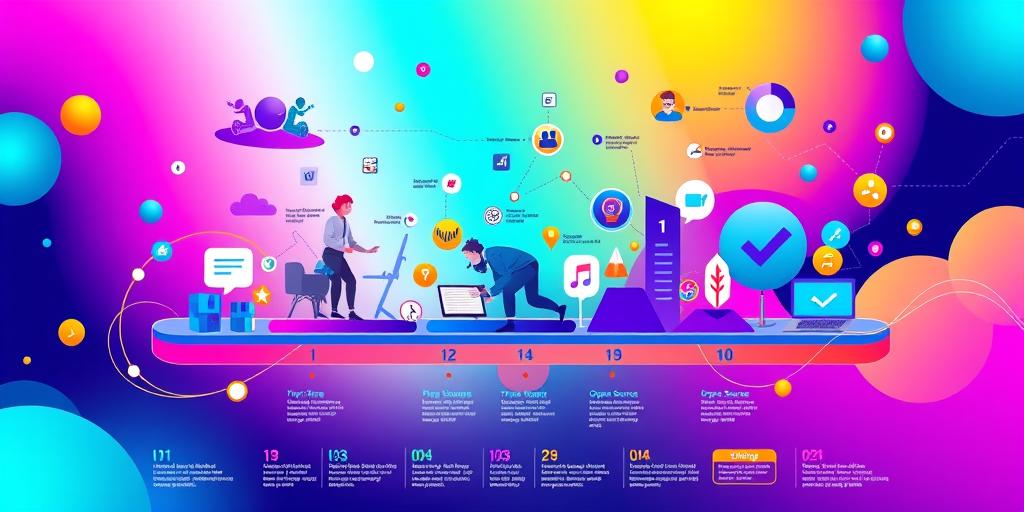Dive into the captivating world of open-source software! Uncover the untold story behind this revolutionary movement that’s reshaping technology as we know it. From its humble beginnings to its current dominance, we’ll explore the collaborative spirit, the surprising benefits, and the unexpected challenges that define open source. Prepare to be amazed by the power of community and the impact it’s having on the digital landscape.
The Genesis of Open Source: A Collaborative Revolution
The history of open-source software is a fascinating tapestry woven with threads of collaboration, innovation, and a shared belief in the power of collective intelligence. Unlike proprietary software, where source code is jealously guarded, open-source projects embrace transparency. This means anyone can view, modify, and distribute the software’s source code. This radical approach, initially met with skepticism, has blossomed into a global phenomenon, fostering a vibrant ecosystem of developers, contributors, and users.
Early Pioneers and the Rise of Free Software
The seeds of open source were sown long before the term itself was coined. Early pioneers, driven by ideals of freedom and collaboration, laid the groundwork. Richard Stallman’s GNU project and Linus Torvalds’ creation of the Linux kernel are pivotal moments in this history. Their vision – software freedom and community-driven development – fundamentally altered the trajectory of the tech world. These early projects demonstrated the power of collective effort and the potential for building robust, high-quality software through collaborative means. This laid the foundation for what we know today as the open-source movement, significantly impacting the software development landscape.
The Birth of the Open Source Initiative
The term “open source” emerged in the late 1990s as a more business-friendly and less ideologically charged term than “free software.” The Open Source Initiative (OSI) was formed to create a more inclusive and commercially acceptable definition of open-source software, which further propelled its adoption. The OSI’s definition provided a clear set of criteria for qualifying software as open source, ensuring that the principles of collaboration and accessibility were upheld. This clarity was crucial in encouraging broader participation and adoption by businesses and developers alike, fostering even further growth and innovation within the open-source community.
The Power of Open Source: Benefits and Advantages
Open-source software offers a multitude of advantages that have contributed to its widespread adoption. One of the most significant is the unparalleled level of transparency and community scrutiny. Many eyes reviewing the code drastically reduces the likelihood of bugs and security vulnerabilities, leading to a more robust and reliable product. This collaborative security model is a significant advantage over proprietary software where code is kept hidden from public view.
Cost-Effectiveness and Flexibility
Open-source software often comes with a significantly lower price tag than its proprietary counterparts, making it an attractive option for individuals and organizations with limited budgets. The flexibility of open-source software is another key benefit; it can be customized and adapted to meet specific needs, far exceeding the rigidity of most commercial products. This allows developers to tailor the software to their workflows, enhancing productivity and efficiency.
Fostering Innovation and Collaboration
The open nature of development fosters a vibrant culture of innovation and collaboration. Developers from around the globe contribute their expertise, leading to rapid improvements and the addition of new features. This constant evolution ensures that open-source software remains at the cutting edge of technology and often outpaces proprietary alternatives. The community-driven model guarantees that the software remains relevant and responsive to evolving user demands. This constant feedback loop ensures continuous improvement and rapid adaptation to emerging technologies.
Navigating the Challenges of Open Source: Addressing the Concerns
Despite its numerous advantages, open-source software also presents certain challenges. One common concern is the potential for security vulnerabilities. While the community-based review process helps mitigate these risks, it’s not foolproof. Moreover, the lack of centralized support can sometimes make troubleshooting more difficult for users unfamiliar with the community support structures.
Support and Maintenance Issues
Open-source projects often rely on volunteers for support and maintenance. While this community-driven approach is a strength, it can also result in inconsistent support quality and response times. Finding reliable and timely assistance can be challenging compared to the dedicated support teams usually provided with commercial software solutions. Therefore, it is crucial to carefully assess the project’s community activity and available resources before relying on open-source solutions for critical applications.
Licensing and Legal Considerations
The various open-source licenses can be complex, and understanding their implications is crucial. Each license governs how the software can be used, modified, and distributed. Businesses need to carefully review these licenses to ensure compliance, especially in larger projects where multiple components with varying licenses may be involved. The choice of a proper license also impacts the kind of contribution the project can accept and the flexibility offered to users. Choosing the right license, therefore, requires careful consideration of legal and commercial factors.
The Future of Open Source: A Bright Horizon
The future of open-source software appears exceedingly bright. The growing popularity of cloud computing, containerization, and DevOps practices is further solidifying its position as a dominant force in the tech industry. As more developers and organizations embrace open-source principles, we can expect even greater innovation and collaboration. The future promises further growth and adoption of open-source software, leading to faster technological advancements and increased accessibility.
Open source is not merely software; it’s a movement—a collaborative spirit that is revolutionizing the way technology is built, shared, and used. Join the movement! Explore the vast world of open-source possibilities and become a part of the future of software development.




